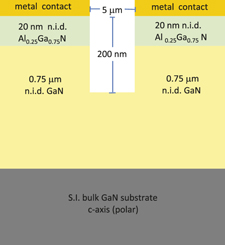Article contents
Dislocations as quantum wires: Buffer leakage in AlGaN/GaN heterostructures
Published online by Cambridge University Press: 24 April 2013
Abstract

Buffer leakage in aluminum gallium nitride/gallium nitride (AlGaN/GaN) heterostructure transistors is recognized as an issue that has deleterious consequences on device performance for high-power, high-frequency transistors and has been related to the presence of uncharged threading screw dislocations. In this study, we demonstrate that measurements of buffer leakage in AlGaN/GaN heterostructures grown on bulk gallium nitride (GaN) substrates are consistent with a mechanism based on the concept of dislocations acting as quantum wires in series with unintentional silicon (Si) impurity incorporation at the bulk GaN substrate/GaN buffer interface. The number of electronic channels N deduced from the leakage data using Landauer’s formula for the quantum resistance of N electronic channels is consistent with the number of dislocations along the ohmic contact pads determined from panchromatic cathodoluminescence and x-ray diffraction measurements of the dislocation density. This mechanism is consistent with Shockley’s suggestion that dislocations can act as one-dimensional conductors due to the presence of edge states along the dislocation core.
Keywords
- Type
- Articles
- Information
- Journal of Materials Research , Volume 28 , Issue 13: FOCUS ISSUE: Frontiers in Thin-Film Epitaxy and Nanostructured Materials , 14 July 2013 , pp. 1687 - 1691
- Copyright
- Copyright © Materials Research Society 2013
References
REFERENCES
- 10
- Cited by


